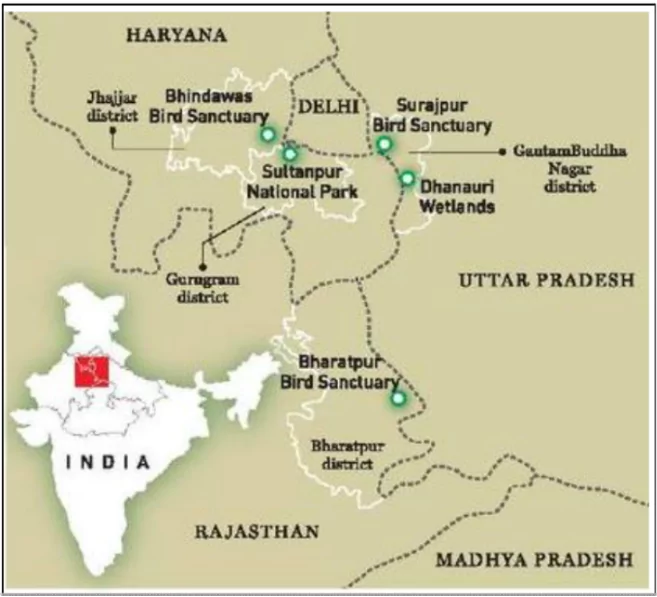The National Green Tribunal (NGT) directed the Uttar Pradesh (UP) government to explain the delay in notifying the Dhanauri water body near Jewar airport as a wetland.
Key Highlights of NGT Directives
- Status Report Deadline: The NGT directed the UP government to submit a status report within four weeks on notifying Dhanauri water body as a wetland.
- Delay Clarification: The tribunal questioned the three-month consultation timeline with landowners, despite the decision to notify the wetland already being made.
- Conservation and Land Issues: The wetland spans 112.89 hectares, mostly private land in villages like Dhanauri Kalan and Thasrana, necessitating landowner consultations. The NGT stressed the importance of conserving bird habitats, including for migratory species, amid Jewar airport operations.
- Ramsar Site Potential: The petitioner emphasized Dhanauri’s eligibility as a Ramsar site and bird sanctuary, urging state and central coordination. Future hearings will address these matters comprehensively.
Enroll now for UPSC Online Course
About Dhanauri Wetland

- Dhanauri Wetland: It is a Bird-watching area located in Dhanauri village in Gautam Buddha Nagar district, Uttar Pradesh.
- The wetland is already home to 217 bird species.
- During peak migratory seasons, between November and March, the population of waterfowl reaches up to 50,000.
- It is home to around 150 Sarus Crane which is also the State Bird of Uttar Pradesh.
- Recognition: It has received recognition as an Important Bird Area by Bird Life International and has been documented by the BNHS (Bombay Natural History Society).
Ramsar Site Designation Criteria
- Representing rare or unique natural wetland types.
- Supporting endangered species or threatened ecological communities.
- Maintaining biodiversity in specific biogeographic regions.
- Offering refuge during adverse conditions.
- Regularly accommodating 20,000 or more waterbirds.
- Sustaining 1% of a population of a single water-bird species.
- Serving as a critical source of food, spawning grounds, nurseries, and migration paths for fish.
- Regularly supporting 1% of a population of non-avian wetland-dependent animal species.
Dhanauri wetland fulfils two key Ramsar site criteria out of nine
- It hosts over 1% of the biogeographic Sarus crane population.
- The area serves as a congregation site for 20,000+ waterfowls and various other species.
Check Out UPSC CSE Books From PW Store
What is a wetland ?
- Ramsar Convention on Wetlands defines wetlands as “Areas of marsh, fen, peat land or water, whether natural or artificial, permanent or temporary, with water that is static or flowing, fresh, brackish or salt, including areas of marine water the depth of which at low tide does not exceed six metres.”
- Comprise areas that transition between terrestrial (land) areas and aquatic (water) areas.
- Regulatory Framework: The Ministry of Environment, Forest and Climate Change (MoEF&CC) has notified Wetlands (Conservation and Management) Rules, 2017 under the provisions of the Environment (Protection) Act, 1986 for conservation and management of wetlands in India.
- Recognition of Wetland: By the state government.
Ramsar Convention
- Named after Ramsar in Iran where the convention was ratified in 1971 which came into force in 1975.
- Three pillars of the Convention are:
-
- Work towards the wise use of all their wetlands.
- Designate suitable wetlands for the list of Wetlands of International Importance (the “Ramsar List”) and ensure their effective management.
- Cooperate internationally on transboundary wetlands, shared wetland systems and shared species
Ramsar Sites of India
- As of August 2024, India has 85 Ramsar sites which is highest in South Asia.
- Tamil Nadu with 18 sites has the most Ramsar sites in India followed by Uttar Pradesh with 10 sites.
- These sites play a crucial role in supporting biodiversity, protecting endangered species, and ensuring sustainable use of water resources.
- The addition of Dhanauri to this prestigious list would further solidify India’s commitment to wetland conservation, supporting its diverse birdlife and ecosystems.
Enroll now for UPSC Online Classes
Montreux Record
- Maintained as part of the Ramsar List.
- Register of wetland sites on the List of Wetlands of International Importance where changes in ecological character have occurred, are occurring, or are likely to occur as a result of technological developments, pollution or other human interference.
- Two wetlands in India are currently on the Montreux Record:
- Keoladeo National Park; Rajasthan
- Loktak Lake; Manipur
Ready to boost your UPSC 2025 preparation? Join PW’s UPSC online courses today!
![]() 23 Jan 2025
23 Jan 2025


